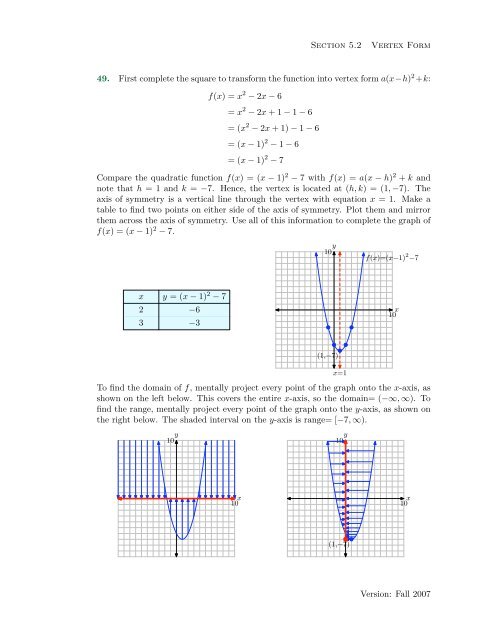Chapter 5: Exercises with Solutions
Chapter 5: Exercises with Solutions
Chapter 5: Exercises with Solutions
- No tags were found...
You also want an ePaper? Increase the reach of your titles
YUMPU automatically turns print PDFs into web optimized ePapers that Google loves.
Section 5.2Vertex Form49. First complete the square to transform the function into vertex form a(x−h) 2 +k:f(x) = x 2 − 2x − 6= x 2 − 2x + 1 − 1 − 6= (x 2 − 2x + 1) − 1 − 6= (x − 1) 2 − 1 − 6= (x − 1) 2 − 7Compare the quadratic function f(x) = (x − 1) 2 − 7 <strong>with</strong> f(x) = a(x − h) 2 + k andnote that h = 1 and k = −7. Hence, the vertex is located at (h, k) = (1, −7). Theaxis of symmetry is a vertical line through the vertex <strong>with</strong> equation x = 1. Make atable to find two points on either side of the axis of symmetry. Plot them and mirrorthem across the axis of symmetry. Use all of this information to complete the graph off(x) = (x − 1) 2 − 7.y10f(x)=(x−1) 2 −7x y = (x − 1) 2 − 72 −63 −3x10(1,−7)To find the domain of f, mentally project every point of the graph onto the x-axis, asshown on the left below. This covers the entire x-axis, so the domain= (−∞, ∞). Tofind the range, mentally project every point of the graph onto the y-axis, as shown onthe right below. The shaded interval on the y-axis is range= [−7, ∞).x=1y10y10x10x10(1,−7)Version: Fall 2007
















